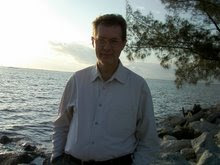Jesus and Mary are together again, at the beginning of his ministry in Cana and now at the end of his public ministry at the foot of the Cross. The Lord refers to his mother as woman at the Wedding Feast of Cana (John 2:1-11) and in this passage, recalling the woman in Genesis 3:15, the first Messianic prophecy of the Redeemer, and anticipating the woman clothed with the sun in Revelation 12.
What sorrow must fill Mary's heart, to see her Son mocked, tortured, and crucified. Once again, a sword pierces Mary's soul: we are reminded of the prediction of Simeon at the Temple (Luke 2:35) . There are four at the foot of the cross, Mary his Mother, John, the disciple whom he loved, Mary of Cleopas, his mother's sister, and Mary Magdalene. He addresses his third word to Mary and John, the only eye-witness of the Gospel writers.
But again Jesus rises above the occasion, and his concerns are for the ones that love him. The good son that He is, Jesus is concerned about taking care of his mother. In fact, this passage offers proof that Jesus was the only child of Mary, because if he did have brothers or sisters, they would have provided for her. But Jesus looks to John to care for her.
St. Joseph is noticeably absent. The historic paintings, such as Tondodoni by Michelangelo and The Holy Family by Raphael, suggest Joseph was a considerably older man. St. Joseph had probably died by the time of the crucifixion, or else he would have been the one to take care of Mary. Early Christian traditions and the second-century apocryphal Protoevangelium of James held that Joseph was a widower, and his children by his former wife were the "brothers and sisters of Jesus."
Another striking phrase indicating Jesus of Nazareth was an only child is Mark 6:3, referring to Jesus: "Is not this the carpenter, the son of Mary, and the brother of James and Joses and Judas and Simon, and are not his sisters here with us?" Now if James, Joses and Judas and Simon were also natural sons of Mary, Jesus would not have been called the "son of Mary," but rather "one of the sons of Mary."
Subscribe to:
Post Comments (Atom)






No comments:
Post a Comment